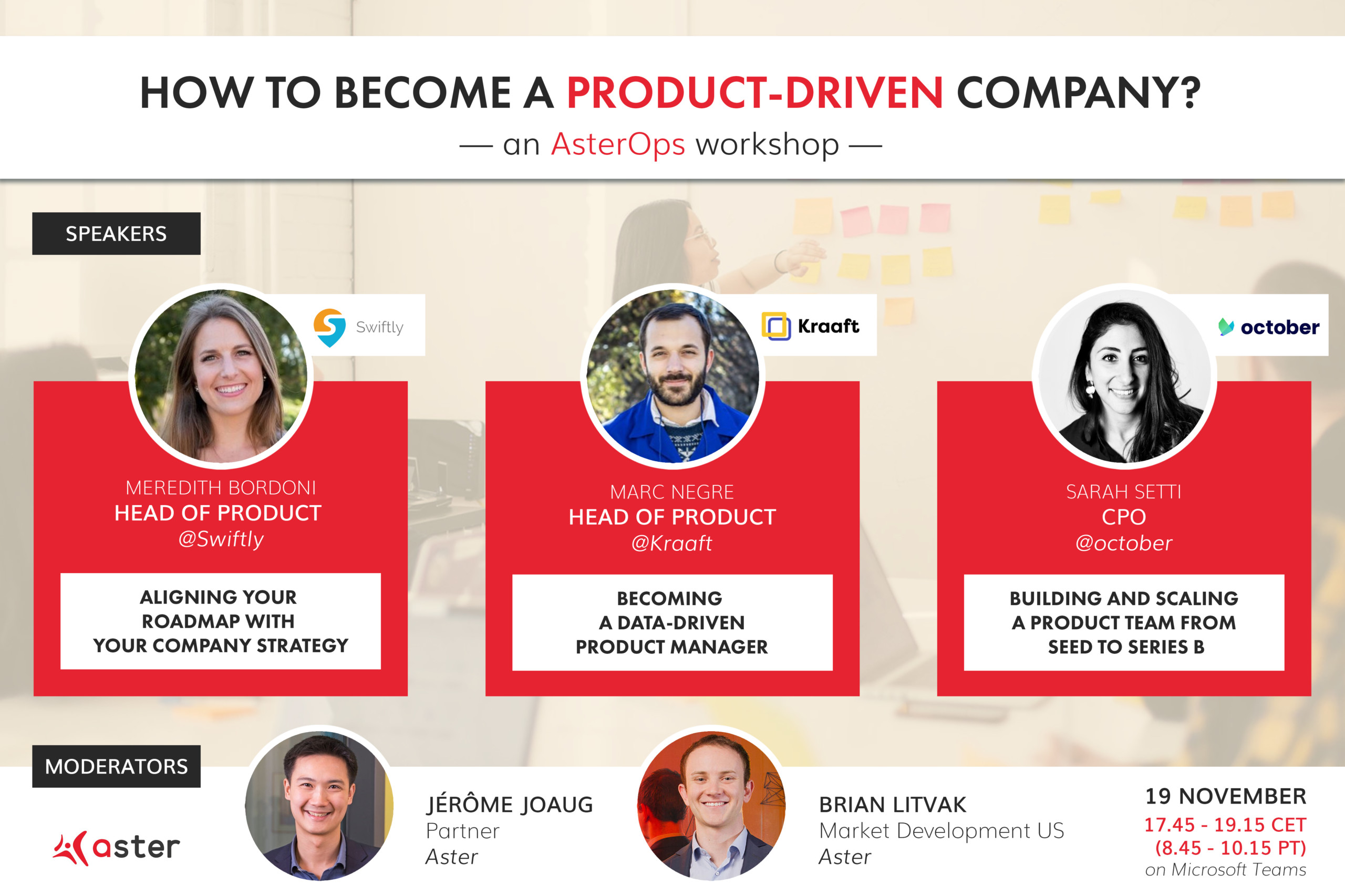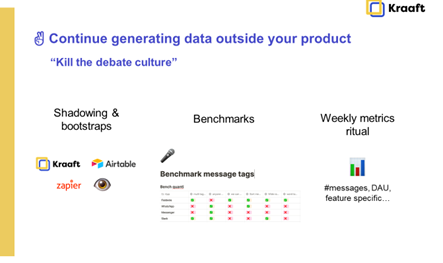At Aster, we believe product management plays a crucial role in the long-term success of a startup. Having partnered with more than 70 startups, we have seen firsthand how founders and product managers can face hurdles in deciding how to allocate resources to:
- Ensure a continuous alignment between ideas added into products and the overarching company strategy
- Optimize or launch new products based on usage data and customer feedback
- Build and scale product teams as the company grows
To help founders and early-stage product managers tackle these challenges, Aster decided to host a webinar with three product experts who shared their insights on how to become more product-focused:
- Meredith Bordoni, Head of Product at Swiftly
- Marc Negre, Co-founder and Head of Product at Kraaft
- Sarah Setti, Chief Product Officer at October
This webinar was our first AsterOps workshop, an initiative at Aster to support early-stage startups both in our portfolio and across the broader ecosystem. AsterOps provides a platform to learn from experts on how to approach and address the common operational challenges that startups face.

Here are the key takeaways in case you missed the webinar!
“I believe there is no recipe for success for building a product roadmap,” says Meredith. “If there was a recipe, then there would be many more successful startups out there,” Meredith adds.
Many would define a roadmap as a set of features to get from A to B, but Meredith highlighted that a roadmap can be viewed as a “path to an imagined destination”, which should adapt over time with market validation. Meredith also prefers to think of a product roadmap as an investment map, as it is mostly a set of actions a team will invest time on.
Meredith also shared a “Hows and Whys” framework, which borrows from the 5 Whys for root cause analysis, to help startups align their product investment map with their overarching company vision. At Swiftly, Meredith implements this framework across two processes: first, by setting a top-down vision of what the company wants to realize and addressing the “hows” – using the Objectives and Key Results (OKR) method – and then, asking the “whys” of what you are doing using a bottom-up approach.

2. Don’t trust your users.
“Asking is good, but shadowing is better,” said Marc, highlighted the importance of supporting qualitative user interviews with actual quantitative data on how the product is used to help eliminate bias. Pre-market fit, he typically suggests spending days taking inventory on all user actions to understand their real pains.
Marc provided valuable advice on how to use product data from inception to product-market fit, and shared additional lessons he has learned at Kraaft on how to become more data-driven in product management. Marc stressed the importance of quickly bootstrapping a first ‘hacky version’ of the product to put it in the hands of the user and see how it is used.
Once product-market fit is achieved, Marc suggested that product teams should then track “one simple success metric and have weekly interactions with customers about this metric” to help prioritize product initiatives. At Kraaft, Marc tracks Net Promoter Scores, and has calls with users on a regular basis to gather feedback about product releases and determine their overall satisfaction.
Marc also strongly recommends other founders and product managers to read about How Superhuman Built an Engine to Find Product/Market Fit, which highlights how product leaders can analyze customer feedback and optimize their product/market fit accordingly.

Sarah highlighted three of the four stages in a startup’s product lifecycle, and addressed the different objectives and required product profiles for each stage:
- The creation of a product: The first product managers are generally the founders at this stage, and are responsible for testing hypotheses, recruiting beta testers, designing interfaces, and overseeing the recruitment of developers and technical members of the company.
- The pre-product/market fit phase: A minimum viable product MVP has been developed. The appropriate profile to recruit at this stage is a full-stack product manager who can manage strategic and tactical aspects of the product. In other words, this product hire should blend expertise in business (market knowledge, monitoring customer data, creating business plans), UX (design pattern knowledge, user research, prototyping tools) and technical dimensions (architecture, data models, APIs, etc.).
- The post-product/market fit phase: The product has achieved market fit and strong user traction, and now requires more development to innovate and address user issues. Product managers needed at this stage are generally passionate about optimization, analytics and growth marketing, and are more specialized on the part of the product they are in charge of.
Sarah also warned the audience about scaling, which can sometimes give the impression of diluting ownership and accountability, leading to a negative impact on employee motivation and retention.

Sign up for our next AsterOps workshop!
Interested in learning from founders and experts on how to approach and address the common operational challenges that startups face? Then come join our next AsterOps workshop! To join, please sign up here.
About Aster
Aster is a leading European venture capital firm based in Paris with offices in London, San Francisco, Tel Aviv and Nairobi. Aster has raised €520 million through multiple funds with major corporations and institutional players. Specialized in digital transformation and new industrial models, we fund companies that are transforming the way we consume and move around, how industries manufacture, and how people work together.
